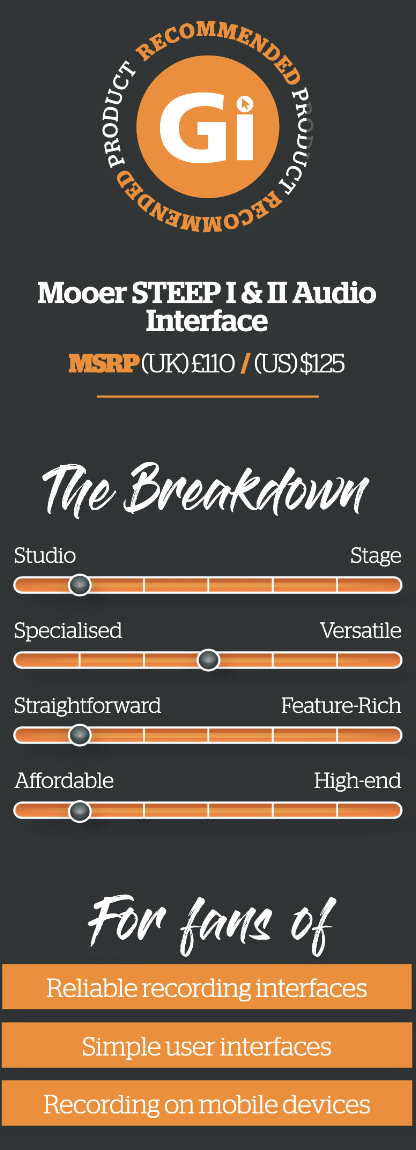

Effects powerhouse Mooer initially carved out a niche as an agile producer of small, budget clones of famous circuits and nano-sized pedals, before pushing its offerings upmarket through multi-FX units (and, most recently, a new generation of smart guitars) all the while maintaining fiercely competitive pricing. Now, the company has its sights set on the increasingly competitive audio interface market with Steep I and II, a pair of units supporting high-res audio up to 24bit/192 kHz. Nick Jennison tells us more.
 You probably know Mooer from their excellent guitar pedals. From kicking off the “mini-pedal” craze to their GE multi-effects pedals, the common threads across the entire Mooer range are quality and affordability. While it might seem as though launching a range of affordable audio interfaces is something of a left-field move for Mooer, it’s actually a feature that’s been included in a number of their guitar pedals and processors for a good few years now. Units like the GE-300 feature high quality, low latency audio interfaces that perform very impressively. So when the Steep I & II stand-alone audio interfaces landed on my desk, I was expecting good things.
You probably know Mooer from their excellent guitar pedals. From kicking off the “mini-pedal” craze to their GE multi-effects pedals, the common threads across the entire Mooer range are quality and affordability. While it might seem as though launching a range of affordable audio interfaces is something of a left-field move for Mooer, it’s actually a feature that’s been included in a number of their guitar pedals and processors for a good few years now. Units like the GE-300 feature high quality, low latency audio interfaces that perform very impressively. So when the Steep I & II stand-alone audio interfaces landed on my desk, I was expecting good things.
Both the Steep I & II feature a very similar feature set, with two inputs, two outputs and a single headphone output. Both connect via USB and can either be bus powered or (if the device you’re connecting to doesn’t provide enough juice) by connecting a standard USB-C charger like the one you use to charge your phone. They work seamlessly on PC and Mac, but they can also be used with mobile devices like smartphones and tablets - a welcome feature considering how many great music-making apps are available on iOS and Android these days.
The key differences between the two models are the number of XLR inputs, and MIDI I/O - the Steep II has two combi XLR/jack inputs, while the Steep I has just one of these alongside a dedicated jack input for connecting instruments and line-level devices. The Steep II has 5-pin DIN MIDI in and out, while the Steep I doesnot.
Controls are very simple indeed - there’s no specialised control software to install, and the top panel is very easy to understand. Each input has a gain control, offering a healthy 50db of gain and a very useful input meter as opposed to the combined “signal/clip” LEDs found on other interfaces in this price range. There’s a button for 48v phantom power, and another for stereo input monitoring, which pans the inputs hard left and right - handy if you’re recording using a modeller, synth or other such device running in stereo. The output section features independent monitor and headphone volume knobs and a “mix” knob for setting the balance between the signal coming from your DAW and the direct signal from your inputs, allowing for zero-latency monitoring - very important for latency-sensitive performers like vocalists and guitarists!
In terms of performance, the Mooer Steep I & II are very hard to find fault with. The audio is clear and uncoloured, the latency is low on both my M1 Mac Studio and my ageing 2013 MacBook Pro, and setup is a breeze. There’s nothing interesting or exciting to report on here, but with an audio interface that’s a good thing - it just works.
Offering rock-solid performance, ease of use and very robust build quality, the Steep I & II are very hard to fault. If you don’t need two mic inputs or MIDI, you can save a few quid by going for the Steep I, but given how affordable these interfaces are (and the relatively small difference in price between the two models), you’d be just as well going for the II. Either way, if you’re a guitar player that needs a simple, reliable interface, these units have you covered.
For more information, please visit:
For more of our latest reviews, click here

We will never share your email without your prior consent. Please see our full Terms & Conditions and Privacy Policy

We will never share your email without your prior consent. Please see our full Terms & Conditions and Privacy Policy